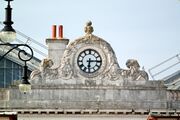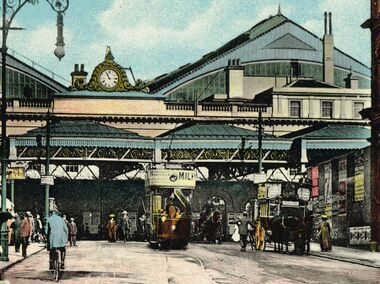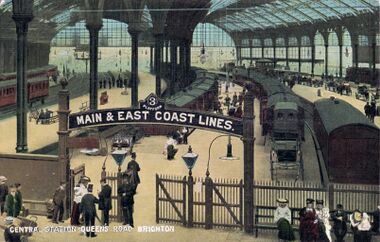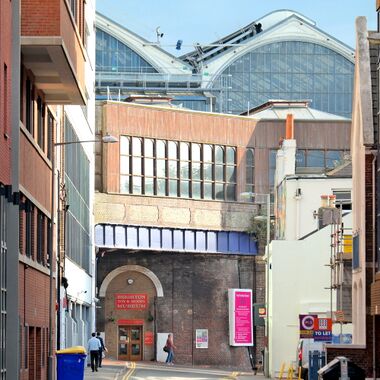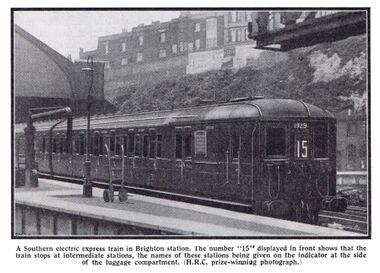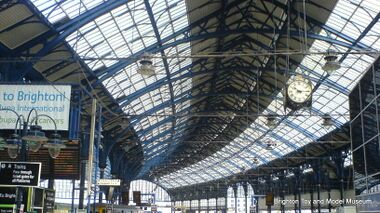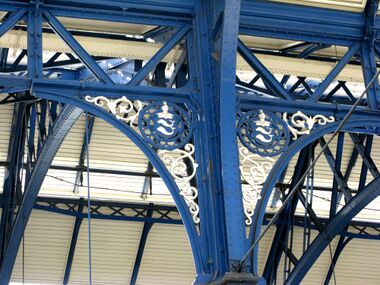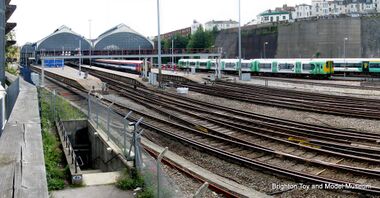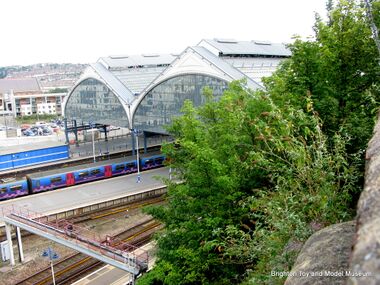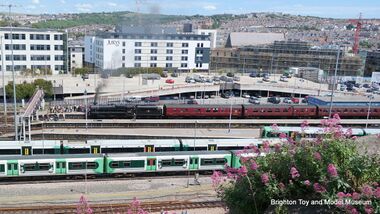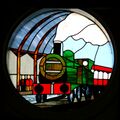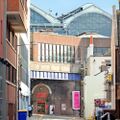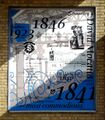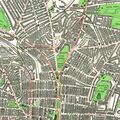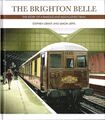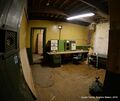Category:Brighton Station
| Brighton Station |
|---|
Brighton Station |
|
Station | History | CabRoad | GoodsTunnel | LocoWorks | Greenway | ToyMuseum |
1908 or earlier: Central Station, Brighton, detail from a postcard postmarked 1908. The photograph includes a horsedrawn bus, a hansom cab, an electric tram, and two gentlemen with bicycles. Sign to the far left is for the old Terminus Hotel, since demolished. [image info]
Brighton Statues and Landmarks -0.14101588457656875 coordinates: 50.828853376855335, -0.14101588457656875
~1910: Platform 3, with horsedrawn vehicle [image info]
Brighton Toy and Model Museum entrance, with Brighton Station cab rank above [image info]
Southern Electric train at Brighton Station, photograph published in 1936. [image info]
Brighton Station's blue roof supports [image info]
Brighton Station, blue girderwork including roundels with the helmet and dolphins of Brighton's coat of arms [image info]
Brighton Station approach, showing "cliff" [image info]
Brighton Station, view from the top of the "cliff" [image info]
"Black Five" steam loco 44932 at Brighton Station, 8th June 2014, for the "Seaford150" 150th anniversary of the Brighton to Seaford line. The area to the rear of the photograph was originally occupied by the locomotive works [image info]
Brighton Railway Station, "BTN" was built in 1841 by the London and Brighton Railway (L&BR) as the southern terminus of their new London-to-Brighton railway line, expensively engineered to give as direct a route as possible between the new station and the other custom-built terminus, London's Victoria Station (which was shared with another company). The building, a white rectangular Italianate building designed by David Mocatta, was one of a chain of similar station buildings created by Mocatta along the railway line, with the Brighton Terminus doubling as the company's headquarters. Mocatta's building is still on-site, embedded in the front of the larger modern station, which flanks the original building with additional office space, connected to the Mocatta building on the first floor.
Technically there was a "Brighton Station" on the site in 1940, but this was a smaller temporary building that only served the Brighton-to-Shoreham line while the main line to Brighton (and its main station building) were still being completed.
The site
Carved into the side of a steep hill, the site seemed to be a crazy position for a railway station, but the location (plus a viaduct crossing London Road) allowed a single station to service both the London line and coastal lines to the East and West.
Access
The main access route to the station was originally Trafalgar Street, which connected the station to Grand Parade. The station had a Cab Road on the East side taking vehicles up the extra level to the platform level, folded back on itself with a 180-degree hairpin bend in an attempt to make the road twice as long, and half as steep. However, this wasn't ideal, and Queens Road was built to connect the station to North Street, by the subsequent Clock Tower. Queens Road was carefully designed to have a much gentler slope, and the top led into the station via a new bridge over Trafalgar Street. The built-up station forecourt designed to carry the bridge is now home to Brighton Toy and Model Museum.
Development
The forecourt to the station (including the space now occupied by Brighton Toy and Model Museum) was probably added some time in the next year or two after 1841, and the west side of the site became built up with additional offices. A need for additional office and platform space was then met by extending the station Eastwards and encroaching on the goods yard, bridging over the old Cab Road and turning it into an access tunnel (which still exists, behind the wooden doors alongside the museum). A set of glass roofing was also built over the forecourt to provide shelter for visitors, although this obscured the view of the original Mocatta building – while it seems anomalous that the site could be so heavily redeveloped without replacing the original (now heavily obscured) building, one theory is that the Company's Directors liked the Mocatta boardroom and didn't want it changed.
Railway companies
In 1846, around five years after the new line was opened, the L&BR merged with others to become the London, Brighton and South Coast Railway (LB&SCR), which retained the building as their headquarters. With the creation of the "Big Four" railway companies in 1923, the LB&SCR then became a major part of the Southern Railway (SR). With nationalisation in 1947, SR then became British Railways Southern Region.
Goods yard and Brighton Works
To the East of the station was a goods yard, which, due to the site's slope, was a level lower than the passenger lines, and was originally linked to the West by a steep tunnel angled diagonally beneath them - this was later made obsolete by a dedicated ironwork bridge over New England Road (now part of the Brighton Greenway), with a longer arcing route that had a more sensible gradient.
Brighton Locomotive Works also occupied land to the North and East, producing over 1200 steam locomotives (including the Billinton E2 Second Series 0-6-0 tank locomotive that was used as the famous outline of Thomas the Tank Engine), and with the Pullman Works at Preston Park servicing Pullman carriages. At one time the site included an Isetta bubble-car factory, with raw materials and finished cars entering and leaving by rail.
This area has since been extensively redeveloped and built on to produce Brighton's New England Quarter.
See also:
External links
- Listing 1380797: Brighton Station (historicengland.org.uk)
- UK Transport Wiki: Brighton Railway Station
- Robert Nemeth on Brighton Station’s secrets (thelatest.co.uk)
- The Victorian Web: Brighton Railway Station (victorianweb.org)
- Brighton Station (mybrightonandhove.org.uk)
- Brighton Railway Station (wikipedia.org)
- 1974: Open Day at Brighton Station (player.bfi.org.uk) – video – sharp-eyed viewers may be able to spot a young Chris Littledale at: 00:01:05 .
Subcategories
This category has the following 12 subcategories, out of 12 total.
B
- Brighton Greenway (1 P, 8 F)
- Brighton Station Cab Road (13 F)
H
L
- London Road Viaduct (5 F)
O
- Ouse Valley Viaduct (1 P, 6 F)
Q
S
T
Pages in category ‘Brighton Station’
The following 8 pages are in this category, out of 8 total.
Media in category ‘Brighton Station’
The following 53 files are in this category, out of 53 total.
- Anthony Dowsett, Community Rail Partnership (LatestTV 2018-03-21).jpg 960 × 541; 203 KB
- Brighton Belle Mural, early sketch.jpg 1,173 × 683; 126 KB
- Brighton Belle plaque.jpg 2,048 × 1,536; 565 KB
- Brighton From the Terminus (Railway Chronicle Travelling Chart, ~1846).jpg 4,494 × 1,650; 1.79 MB
- Brighton Greenway approach, seating and Brighton Station (June 2016).jpg 2,000 × 1,334; 669 KB
- Brighton Railway Station building, clock.jpg 2,200 × 1,467; 1.73 MB
- Brighton Station (stained glass at Brighton Palace Pier).jpg 1,600 × 1,600; 219 KB
- Brighton Station approach (Brighton Greenway, April 2016).jpg 2,500 × 1,667; 2.93 MB
- Brighton Station cliff.jpg 2,000 × 1,500; 1.15 MB
- Brighton Station enamelled sign.jpg 3,000 × 1,001; 446 KB
- Brighton Station girderwork.jpg 2,000 × 1,500; 574 KB
- Brighton Station interior, engraving (NGB 1885).jpg 1,600 × 1,080; 526 KB
- Brighton Station plaques (NLR 2014-09).jpg 1,729 × 2,400; 1.23 MB
- Brighton Station, approach, 2011.jpg 2,106 × 1,099; 482 KB
- Brighton Station, cliffview, 2011.jpg 2,000 × 1,500; 1.71 MB
- Brighton Station, David Mocatta building, rear.jpg 1,024 × 683; 499 KB
- Brighton Station, roof interior, 2011.jpg 1,632 × 915; 343 KB
- Brighton Terminus, lineart (1870s).jpg 1,024 × 605; 455 KB
- Brighton Terminus, lineart (~1840s).jpg 1,024 × 657; 413 KB
- Brighton Toy and Model Museum entrance, seen from Frederick Place.jpg 1,000 × 1,000; 770 KB
- BTMM Brighton Station Poster, layout (BrightonStation 2019).jpg 2,121 × 3,000; 961 KB
- Cab Road 011 (UnderBrightonStation 2018-01-18).jpg 3,000 × 2,000; 3.16 MB
- Cab Road 018 (UnderBrightonStation 2018-01-18).jpg 3,000 × 2,000; 2.9 MB
- Cab Road 019 (UnderBrightonStation 2018-01-18).jpg 3,000 × 2,000; 2.34 MB
- Cab Road 020 (UnderBrightonStation 2018-01-18).jpg 3,000 × 2,000; 3.35 MB
- Cab Road 021 (UnderBrightonStation 2018-01-18).jpg 3,000 × 2,000; 2.77 MB
- Cab Road 022 (UnderBrightonStation 2018-01-18).jpg 3,000 × 2,000; 3.48 MB
- Cab Road used for an art exhibition (NLR 282 2023-10).jpg 2,110 × 3,000; 1.32 MB
- Cab Road, view in (UnderBrightonStation 2018-01-18).jpg 3,000 × 2,000; 3.07 MB
- Cab Road, view out (UnderBrightonStation 2018-01-18).jpg 3,000 × 2,000; 2.48 MB
- Cab Road, view out, deeper (UnderBrightonStation 2018-01-18).jpg 3,000 × 2,000; 2.55 MB
- Catherine Simmons, Community Rail Partnership (LatestTV 2018-03-21).jpg 960 × 540; 232 KB
- Central Station, Brighton, postcard (BootsPelham 136907).jpg 3,000 × 1,905; 3.04 MB
- Central Station, Brighton, postcard detail (BootsPelham 136907).jpg 1,800 × 1,347; 1.41 MB
- Central Station, Queens Road, Brighton, PC 71 (Pictorial Centre 1910s).jpg 3,216 × 2,044; 4.21 MB
- Chris Littledale, Community Rail Partnership (LatestTV 2018-03-21).jpg 960 × 539; 140 KB
- Community Rail Partnership, signing event (2018-03-21).jpg 2,200 × 1,653; 1.61 MB
- Fenchurch Walk Brighton plaque 7 of 7.jpg 1,078 × 1,229; 208 KB
- Goods Tunnel with rooms (UnderBrightonStation 2018-01).jpg 3,000 × 2,000; 3.6 MB
- Intersection of the Cab Road and Goods Tunnel (UnderBrightonStation 2018-01-18).jpg 3,000 × 2,000; 3.82 MB
- John Peel mural, Frederick Place, 2011.jpg 2,200 × 1,650; 580 KB
- Kemp Town Line, Southern Railway, map (BrightonHbk 1939).jpg 2,998 × 3,000; 5.34 MB
- Rifle Range, back view (UnderBrightonStation 2018-01).jpg 3,000 × 2,000; 2.93 MB
- Southern Electric train in Brighton Station (MM 1936-05).jpg 1,800 × 1,293; 700 KB
- Stairs to platform level (UnderBrightonStation 2018-01).jpg 2,400 × 3,000; 2.49 MB
- Steam locomotive 44932 at Brighton Station, 8-June-2014.jpg 2,200 × 1,238; 1.88 MB
- TheBrightonBelle book.jpg 400 × 456; 42 KB
- Wartime offices, Goods Tunnel (UnderBrightonStation 2018-01).jpg 3,000 × 2,532; 3.15 MB
- William Ranieri, Community Rail Partnership (LatestTV 2018-03-21).jpg 960 × 541; 179 KB
